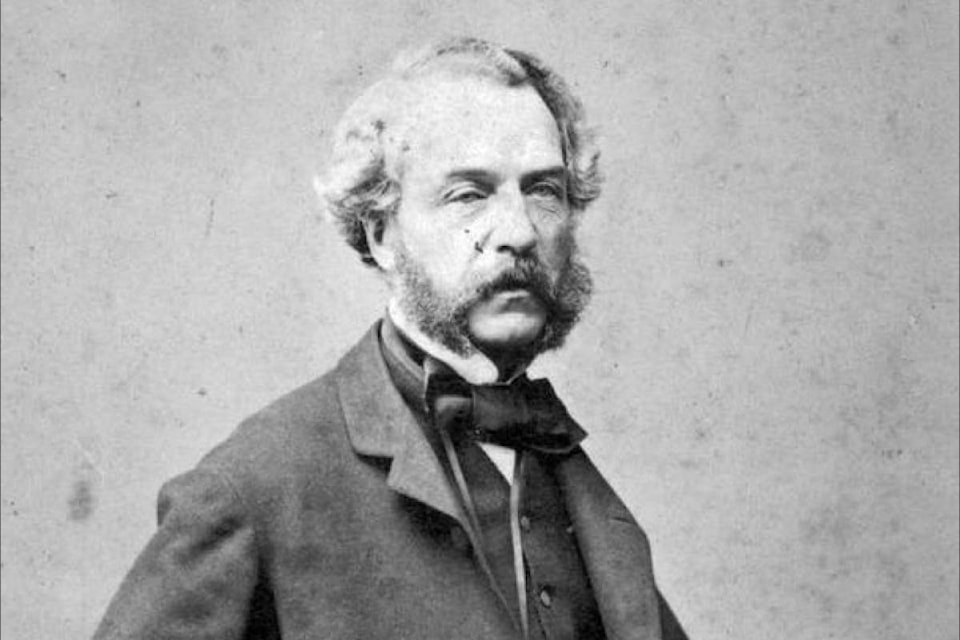This series has mentioned the Cariboo Wagon Road on several occasions, most recently during the set of articles about Yale, which was the starting point for the second Cariboo Wagon Road. Ashcroft resident Esther Darlington—herself a historian—wrote to praise the Royal Engineers who constructed the second road, and lament the fact that their contribution to what was described by some as “the eighth wonder of the world” was not better known.
The Columbia Detachment of the Royal Engineers was established in barracks at Derby Reach (now part of northwestern Langley, and commemorated by Derby Reach Regional Park) in 1858. With the discovery of gold on the Fraser and Thompson Rivers a few months earlier, and the subsequent influx of thousands of gold-seekers to the region, the new Crown Colony of British Columbia was created in November 1858, and the presence of the venerated Royal Engineers was seen as vital to the new colony’s—and the Crown’s—interests.
The 160 Engineers who arrived in 1858 were augmented with another 65 men the following year, and these 225 soldiers—a tiny speck in the huge colony—were charged with three duties. Since they were a military force, they would be a protection against the very real threat of American annexation and feared uprisings by the Native population. As a British presence, it was hoped that they would provide a “civilising” influence on the possibly unruly population of the new colony. And third—and most lastingly—they would, as Engineers, carry out various public works, such as surveying new townsites and constructing roads.
The “Sappers”—as Royal Engineers were nicknamed—at Derby Reach were commanded by Col. Richard Moody, after whom Port Moody was named. Moody had been hand-picked to found the new British colony on North America’s west coast, and was considered the archetype of the “English gentleman and British officer”. He was not only the Commander of the Columbia Detachment of Royal Engineers: he was the colony’s first Lieutenant-Governor, the Chief Commissioner of Land and Works, the designer of British Columbia’s first coat of arms, and the man who established Stanley Park (which was originally intended as a military reserve). Anywhere named “Burnaby” (city, lake) comes from Moody’s secretary, Robert Burnaby, while Mary Hill in Port Coquitlam is named after Moody’s wife (the Mary part, not the Hill).
He selected the site of, and founded, New Westminster, which he intended to be the capital of the new colony (hence “New” Westminster, after Westminster, where the British government is headquartered in London, England). The townsite was surveyed and laid out by the Sappers from their base at Derby Reach (which was known as Sapperton), and they also helped members of the British Boundary Commission survey and mark the 49th parallel—which had been fixed as the boundary with the United States in an 1846 treaty—over some of the most rugged terrain in North America.
Before their term in British Columbia was over in 1863, the Sappers also built public offices and churches, produced much-needed maps of the new territory, surveyed property, and settled land disputes. Many of the men stayed on, established families, and became productive residents of the colony once their service was ended.
That New Westminster failed to become British Columbia’s capital is no fault of Moody’s, and is more than outweighed by the achievement that most would point to as the greatest triumph of his time here: the construction of the second Cariboo Wagon Road.
As has been documented in this series, the first Cariboo Wagon Road—by land and water through Lillooet and Pavilion to Clinton—was less than ideal, requiring numerous transfers from land to water and back again, as well as a formidable climb at Pavilion. By 1861 the gold rush on the Fraser and Thompson was abating, but the discovery of gold in the Cariboo at Barkerville meant that treasure seekers continued to pour into the colony, accompanied by those who would profit from them by the establishment of roadhouses and businesses, as well as ranchers and settlers drawn by the rich promise of the area’s grasslands and natural resources. A new road to the heart of the colony was clearly needed.
Governor James Douglas travelled to Yale in 1861 and looked at the feasibility of a wagon road leading north from the town. As the last point on the Fraser River navigable by ship, Yale seemed a logical starting point for this new road, but the expertise of the Royal Engineers would be needed, considering the terrain that was involved: 400 miles through canyon and wilderness.
It is hard to overstate what vision it took to conceive of such a route, let alone undertake it. The permanent population of the colony of British Columbia at that period was only around 7,000 people, and the construction of a wagon road some 18 feet wide, for 400 miles—the equal of anything undertaken anywhere in North America to that time—doubtless struck many as little short of lunacy. But Douglas persisted, and called in Moody and his Sappers to see if it could be done.
In October 1861 the Sappers were commissioned to survey a route from Yale to Cook’s Ferry (the present-day Spences Bridge) through the treacherous and forbidding Fraser and Thompson canyons. The difficulty of the terrain can be determined from one traveller’s account of a trip made before the road was built:
“We were detained at Lytton and when we started out next morning the snow was four and a half feet deep. We had no snowshoes and the walking was most laborious. We arrived at Yale on December 5, having taken 10 days to make 57 miles.”
We’ll learn more about how the Royal Engineers tackled this challenge in the next instalment.
editorial@accjournal.ca
Like us on Facebook and follow us on Twitter
